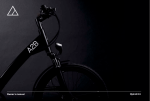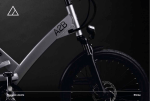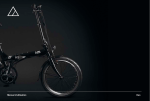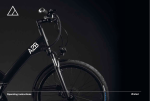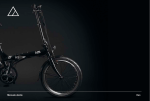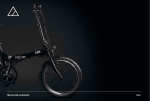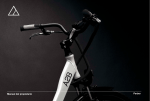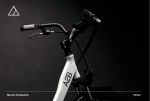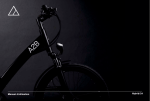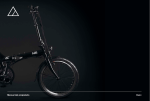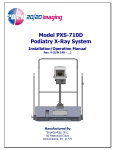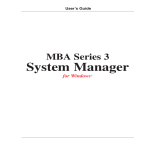Download Owner`s Manual Shima
Transcript
Owner’s Manual Shima 1 Contents 1.0 Introduction 2.0 Important notes 3.0 Your A2B 4.0 Getting to know your A2B 5.0 Using, storing and disposing of the battery 6.0 Important safety instructions before your first ride 7.0 Maintenance 8.0 Cleaning the vehicle 9.0 Troubleshooting 10.0 Technical data 11.0 Warranty and safety notes 12.0Disposal 13.0 Maintenance schedule 14.0 Owners registration 4 5 8 15 24 28 31 37 38 39 40 41 42 50 3 Owner’s manual 1.0 Introduction Welcome and congratulations on buying your new A2B Shima*, the electric bike that’s taking transport in a whole new direction. It’s the revolutionary way to get to work, visit the shops or just get some fresh air. Compared to jumping in the car, an ebike is a lot more fun, easier to park and will reduce your fuel costs as well as your impact on the environment… as you’ll soon find out! Feeling energetic? You can ride your new A2B Shima powered off and then switch the assistance on for hills and headwinds. We dedicated our new bikes to pioneers that redefined the way we do things in the modern World. As a tribute, the A2B Shima bike was named after Hideo Shima, a japanese railway engineer and the driving force behind the development and building of the first bullet train (Shinkansen). Hero Eco A2B Global Head Office Hero Eco Ltd 80 Coleman Street London EC2R 5BJ Germany Hero Eco Ltd Reichenberger Strasse 124 10999 Berlin USA Hero Eco Inc. 207 9th St. San Francisco, CA 94103 www.wearea2b.com * A2B Shima electric bike will be referred to as "A2B" for short in the further course of this manual. 4 2.0 Important notes This owner’s manual contains important safety, performance and service information. Please read it through carefully before your first ride. Your A2B should be fully assembled and the battery charged by your A2B dealer. If not contact us immediately as this will void your warranty. Please ensure that all users of your A2B have read and understood the following important information. • The A2B is suitable for riding on paved streets and roads. Therefore, do not ride off the paved roads or across terrain. Do not use the A2B to cross water, for off-road jumps or for sporting events. • When using the A2B we recommend you always wear an approved helmet and reflective clothing at night. • Make sure that you know and obey the rules of conduct for safe and responsible riding. By choosing to ride the A2B you accept full responsibility. • Your existing insurance policies may not provide accident cover for your A2B. Contact your insurance company or agent for information. Important symbols This indicates a potentially hazardous situation, which if not avoided, may result in serious injury, property or equipment damage or inadvertent system failure. Provides helpful or other important relevant information. If you have any questions or are not sure about any instructions in this owners manual ask your A2B dealer. 5 Owner’s manual 2.1 Your A2B belongs to European Vehicle Category L1e capability (light two-wheel powered vehicle up to 45 km/h (28 mph). Ebikes with up to 45 km/h (28 mph) are also called fast pedelecs (S-Pedelec or Speed Pedelec). The A2B has an operating permit with Type Approval Number e13*2002/24*0639. The applicable existing statutory regulations and legal provisions are explained below. Registration number requirement The A2B as a homologated vehicle must be provided with a valid insurance tag (vehicle insurance). This can be obtained from any insurance company and must be clearly displayed on the registration plate bracket. Helmet requirement At the time this owner's manual was written a standard European helmet requirement does not yet exist. Therefore, after you have purchased your A2B, please consult with your A2B specialist dealer to find out the current legal situation in your country. Driving licence* L1e category light two-wheel powered vehicles may only be driven if in possession of at least a Category M (as of 16 years of age) driving licence. However, we recommend you wear an appropriate helmet for every ride. Where you may ride Riding in bicycle lanes and in pedestrian areas is not permitted for light two-wheel powered vehicles, applicable within and outside city limits. Riding on bicycle streets is only permitted if these streets are generally approved for motor vehicles or motorcycles. This also applies if you ride only by pedalling, without motor assistance. 6 Trailers Please check relevant legislation for your area for a full understanding of all necessary legal requirements. According to US law, light two-wheel powered vehicles may only pull cargo trailers. It is prohibited to attach childrens trailers to a S-Pedelec (your A2B in this case) to transport children. *Not applicable in all markets, please check local legislation. Replacing and modifying components Specific components may only be used if approved for use with a S-Pedelec in the approval documents. When changing components you should only use original parts or attachments which are legally approved for your A2B (or S-Pedelec). This regulation applies to the following components: • • • • • • • • Lights (front and rear) and reflectors Brake system Side stand Electrical system (motor, battery, controller and display) Wheel rims and tyres Frame Registration number bracket Stem and handlebar The rules and principles described here refer to the use of your A2B in the European Union. For use outside the EU you should obtain information beforehand about possible deviations. As European standards and directives for S-Pedelecs have not been unified yet, we would ask you to check if the previously stated information is still current at the time you purchased your A2B. You will find more information at your A2B specialist dealer and at www.weareA2B.com. Unfit state to drive Avoid using your A2B if you feel unwell and not completely fit. Do not ride your A2B while under the influence of medication, drugs or alcohol. Local law enforcement may issue a fine or criminal conviction for riding under the influence of medication, drugs or alcohol. 7 Owner’s manual 3.0 Your A2B 3.1 Components 1. Seat (saddle) 2. Seat post 3. Seat post clamp 4. Frame 5. Display 6. VIN (Vehicle Identification Number) 7. Front light 8. Splash guard front 9. Front wheel 10.Front rim 11.Quick release front wheel 12.Front disc brake and rotor 13.Name-plate (left side) 14.Pedals, crank arm and chain ring 15.Chain 16.TMM4 Sensor 17.Motor 5 27 1 6 26 7 2 8 3 4 25 24 23 22 13 21 20 19 12 16 18 17 8 15 14 9 11 10 18.Rear rim 19.Rear wheel 20.Kickstand 21.Derailleur and free-wheel 22.Bracket for registration number 23.Rear light 24.Splash guard rear 25.Battery connector 26.Battery 27.Rack 28.Right side brake lever (for rear brake) 29.Left side brake lever (for front brake) 30.Gear shifter 31.Right pedal 32.Left pedal 33.Rear view mirror 28 31 30 32 29 33 9 Owner’s manual 3.2 Changing components or attaching accessories Before you install any components or accessories (including other tyres), ask your Hero Eco specialist dealer whether these are suitable for your A2B. Read and comply with the instructions of the respective components or accessories which you have purchased for your A2B. Follow the manufacturer's instructions for the components or accessories if they differ from these instructions. 10 A2B maintenance schedule Your A2B should be professionally maintained by an A2B specialist dealer at regular intervals. Read the information in chapter 13.0 (pg. 42) to that effect. The replacement of components or installation of accessories is at your own risk, since these parts have not been checked by Hero Eco for suitability, reliability or safety with your A2B. 3.3 Brake lever adjustment Just as for all mechanical components, your A2B is also subject to a certain degree of wear. Especially in cases of high loads, attention must be paid to wear characteristics. When the useful life of a component is exceeded it can cause the unexpected functional loss of this component, resulting in serious injuries or even death. Therefore, pay attention to wear characteristics such as cracks, scratches and changes in colour at highly stressed points on the frame, fork, running wheels and handlebars which would indicate that the useful life has been reached or exceeded. Have your specialist dealer immediately replace worn components. Can you comfortably operate the brake lever? If not, take your A2B to your A2B specialist dealer and ask them to adjust the angle of the brake levers. If any components or accessories are not checked for suitability and if they are not installed, used and maintained properly, this may result in serious injuries or even death. The use of non original components or spare parts can jeopardise the safety of your A2B, and can invalidate your warranty. To adjust the brakes you should take your A2B to an A2B specialist dealer. Otherwise you can adjust the brake lever angle yourself: 1. Loosen the screw under the brake lever with an appropriate allen key. 2. Adjust the angle as required. 3. Re-tighten the screw and ensure that the brake lever is securely fixed in position. 3.4 Adjustment of the seat height The seat height may have to be adjusted. Please ask your A2B specialist dealer to adjust the seat height before your first tour. You may also adjust the seat height on your own as indicated below: Determination of the correct driver's seat height There are several ways of determining the correct seat height; the method which can be carried out without any further auxiliary means is described in the following: Sit on the saddle and stretch one leg. Put your foot's heel on the pedal which is on the lowest point of the crank turn. Your knee should now be almost straightened. If you are sitting straight on the saddle while having this position, the saddle's height is correct. Of course, you then do not drive with legs stretched. If you put your foot on the pedal while having the correct driving position (ball of foot and metatarsophalangeal joint above the pedal axle), the knee will remain slightly angled also on the lowest point of crank turn if the saddle height has been adjusted correctly. A short test ride is recommended to find out if the saddle is too high. If the pelvis tilts to the right and the left in the rhythm of pedalling, the saddle is too high. If the saddle is too low, you will usually find it out only after many kilometres through pain in the knees. 11 Owner’s manual Inside leg length Frame height 2.5 cm Gap Frame Height 12 Inside leg length Frame Height Height adjustment 1. The seat height can be adjusted by loosening the quick release for the saddle post. 2. Position the saddle at the desired height. Do NOT position the saddle higher than the minimum insertion mark located on the saddle post BY NO MEANS. 3. Push the lever of the quick release towards the frame, until it will be closed again. The lever must not stick out to avoid danger of injuries. The lever is safely attached if you must use efforts to push it into the closed position. The efforts are appropriate if the lever leaves a mark on the palm of your hand when pressing. A properly closed quick-release cannot be moved anymore unless it is reopened as specified above. If you can move the mechanism slightly, open the lever of the quick release, turn the adjusting nut by another 180° and try again. 4. After height adjustment, check if the saddle cannot be moved in any direction. An improperly attached saddle may lead to severe or even fatal injuries. Ensure that the saddle clamp screw (saddle post saddle) has been tightened using 18.5 Nm. • This user manual does not express any guarantee as to the safe use of the A2B under all conditions. 3.5 Adjusting the handlebar 1. Loosen the screws (A) with an appropriate allen key. 2. Align the centre of the handlebar to the stem. 3. Rotate the handlebar to the required angular position. 4. Evenly tighten the screws (A) to 5 Nm. A Caution: This is an A headset stem, the upper screw (D) is a pre-stressed bolt and does not serve to adjust the stem! Attempting to tighten screw (D) can damage the upper head. An improperly fastened handlebar and stem can result in serious injuries or even death. 3.6 Setting the adjustable stem Alignment of handlebar stem 1. Loosen the screws (B) with an appropriate allen key. 2. Align the stem with the front wheel. 3. Evenly tighten the screws to 15 Nm. B Make sure that the handlebar is securely fastened and that it can be easily operated. Please consult your A2B specialist dealer if you require further help in adjusting the handlebar, bearings and stem. Angle adjustment of the stem 1. Loosen screw (C) with an appropriate allen key. 2. Position the stem at the desired angle. 3. Tighten the screw (C) to 17-18.5 Nm and make certain that the stem is aligned with the front wheel. D C 13 Owner’s manual 3.7 Adjusting the display E 14 1. Loosen the adjusting screw (E) on the underside of the display with an appropriate allen key. 2. Align the angle of the display according to your requirement. 3. Then evenly tighten the screw to 5 Nm. 4.0 Getting to Know your A2B If after reading this section you still have questions, ask your A2B specialist dealer to explain any functions or characteristics that are unclear to you before your first ride. 4.1 Overview 4.2 Your first trip The A2B is equipped with a torque sensor. As soon as you begin to pedal you will discover that the motor starts up and assists you, making cycling an effortless pleasure. In addition to this pedal assistance you will find a starting aid next to the left grip. This starting aid will accelerate the motor up to 20 km/h (12.5 mph), regardless of your pedaling power.* 1. Wear your helmet and choose a quiet location away from cars, obstacles or other hazards. 2. Ensure that the battery is charged and connected. 3. Activate the system with the electronic key (see section 4.3). 4. Do NOT sit down on the A2B while it is still on its kickstand. You will damage the kickstand and possibly the frame. 5. Mount your A2B and find a comfortable sitting position. 6. Step on the pedals to start the motor assistance. 7. Test the brakes at slow speed. The left brake lever operates the front brake, the right brake lever operates the rear brake. 8. Pulling the brake lever too tightly may lock the wheel, causing you to lose control of the ebike. *Not available in all markets Please remember that a motor cut-out is integrated in the right brake lever. The electric power supply to the motor is cut off the moment you activate the right brake lever. Therefore, do not keep the right brake lever operated when you want the motor to run. 9. Try the handling and response of your A2B. Familiarise yourself with how the suspension responds when you operate the brakes and when you shift your weight. 15 Owner’s manual 4.3 Display and electronic key Switching the electronic system on and off at the display Your A2B is secured by an electronic key (also called E-key). You must activate the system before you begin riding. 1. Hold the E-Key directly over the screen of your display. 2. The display now lights up. As soon as the A2B lettering appears, move the E-key away. 3. After the ride: to turn off the system hold your E-Key over the display until it blanks out. The system is now deactivated. 1 The E-Key is used to wake up the display, battery and motor controller from sleep mode. If all of the components do not wake up (e.g. no motor assistance), deactivate the system and repeat the process. 2 16 3 4.4 Display - Functions Overview of functions and menus A. Rotary knob/button B.Battery charge indicator C.Speed indicator D.Mode indicator - shows the selected power level E. Unit indicator (km/h or mph) C D A It is recommended that you regard your E-key like you would a car or house key. It is best to attach it to your private key ring. E B 17 Owner’s manual 4.5 Adjusting the level of assistance Your A2B allows you to choose from three power levels (modes). At top right of the display you can see your current mode. Choosing the assistance level: Turn the knob in order to choose between the different power levels. As soon as the desired mode is displayed, press the knob to confirm the selection. The display then returns to the standard display. Display overview 1. Standard display 2. 0 – off mode (no assistance). 3. Mode 1 – economic (minimum motor assistance, ideal for economizing the battery output, maximum range). 4. Mode 2 – standard (normal motor assistance, normal power, average range per battery charge) 5. Mode 3 – high power (additional motor assistance, maximum power, shortest range per battery charge). 18 1 2 2 4 5 4.6 Set-up (switching between km and miles) miles Turn the knob until the set-up menu (6) appears. Now press the knob for two seconds in order to access the menu. By pressing again (within two seconds) you can now choose between kilometres and miles (7). Then wait to confirm the selection. If you turn the knob in the menu set-up, you will see «ts-value» (8) displayed. This sub-menu permits service technicians and specialist dealers to check for the correct function of the torque sensor. To exit the set-up menu from here, keep turning the knob until the display «back» (9) appears and confirm by pressing once. The standard display (1) will then appear. setup 6 4.7 Switching between total kilometres (odo) and distance counter display (trip) Turn the knob until odo or trip (10/11) appears. Then wait; the system automatically accepts the setting. 7 km back ts-value 8 9 To reset the distance counter: press the knob for two seconds while you are in the trip menu (11). 5.1 The system of your A2B automatically switches to idle mode after it has been inactive for 10 minutes (including the light system). trip 231 odo 10 0.0 11 trip 19 Owner’s manual 4.9 Error codes 16 In the event of an error, the corresponding warning signals (!) and one of the following codes will be displayed: 01 HARDWARE_Brake_SET: Excess current hardware. 02 RECUPERATION: Error energy recuperation. 03 FAST_OVER_VOLTAGE: Fast overvoltage. 04 FAST_UNDER_VOLTAGE: Fast undervoltage. 05 SLOW_OVER_VOLTAGE: Slow overvoltage. 06 SLOW_UNDER_VOLTAGE: Slow undervoltage. 07 OVER_TEMP_135: Motor temperature above 135 °C. 08 OVER_TEMP_INT: Over temperature of the controller. 09 CORRUPT_HALL_VALUE: Motor signal fault. 10 WRONG_HALL_ORDER: Fault motor direction of rotation. 11 not set. 12 R ECOVER_WHILE_DRIVE: Resetting of fault messages during the trip. 13 I_OFFSET_OVER_LIMIT: Offset current over limit. 14 I_OFFSET_UNDER_LIMIT: Offset current under limit. 15 TORQUE_OFFSET_OVER_LIMIT: Offset force sensor over limit. 16 TORQUE_OFFSET_UNDER_LIMIT: Offset force sensor under limit. 20 Error messages are reset automatically when the error no longer exists. In case of a permanent error message, consult your A2B specialist dealer. 4.10 Gears Your A2B has a derailleur that is operated by the right-side gear shifter on the handlebar. To make pedalling easier (e.g. at an incline), press the lever (A) and shift down a gear. You then need to pedal faster in order to maintain the same speed. If you wish to ride faster (on even terrain or downhill), pull the lever (B) and shift up a gear. You can now pedal more slowly but will require more effort. 8 1 A B Never pedal backwards when shifting gears. The chain could derail, making you lose control and could result in accidents with serious injuries or even death and/or property damage. Always pedal evenly after shifting gears. The derailleur operates independently of the motor. Use the derailleur to adjust the gear setting to find a gear that makes pedalling comfortable whilst assisting the motor. 4.11 Lights Set the switch at the rear side of the head light to switch the lights on or off. 21 Owner’s manual 4.12 Rack 7. Evenly distribute the weight of the baggage or objects to be Your A2B is equipped with a fixed frame rack. Please read the transported on both sides of the rack. following instructions carefully before transporting baggage or other objects on the rack. 8. Please note that the baggage or other loads on the rack will change the handling characteristics of your A2B. This affects 1. The rack is fastened to the rack tube with 4x T25 x 18 torx both the steering and braking characteristics. countersunk screws. Ensure that the screws have been tightened with a torque of 6-8 Nm, especially if you will be using the rack 9. Ensure that your baggage does not cover the tail light and frequently. reflectors. 2. Observe that the maximum permitted load is 25 kg (55 lbs). Do not overload the rack! Disregarding these notes can result in serious injuries or even death and/or property damage. 3. Ensure that the baggage is firmly secured to the rack and that it can not fall off during the ride. Ensure that loose straps or other 4.13 Starting aid* objects cannot be caught in the spokes during the ride. Your A2B has a push-start function 4. The rack is not approved for or designed to carry a second at the press of a button which you passenger, to mount a child seat or to pull a trailer. will find on the left side of your handlebar. You can now switch to 5. The permitted total weight of your A2B cannot be exceeded. the motor assistance (A) in order to The permitted maximum total weight is listed in the specification. push your A2B uphill, for example, or to accelerate up to 20 km/h (12.5 6. No changes to the rack, of any kind, are permitted. (You will mph) without using pedal force. The find a sturdy rack which enables the attachment of the diverse level of assistance depends on the panniers in our range of accessories). selected power level. A *Not available in all markets 22 At the end of your ride Switch off the system with your E-Key. Factors affecting range: • • • • • • • • • Level of assistance. Battery charge state. Using the correct gears for the corresponding speed. Tyre inflation pressure. Front wheel bearings and both brakes (tight bearings or dragging brake shoes reduce the range). Rider weight (it takes more energy to accelerate a heavier person). Your speed and local wind conditions (range is reduced when riding fast against a strong wind). Terrain (on soft surfaces or uphill requires more force). Frequent starting and stopping (full force from standstill requires the most power from the battery). Maximise your range • Fully charge your battery before each ride. • Regularly check the tyre pressure and pump up the tyres to a pressure of 2.8 bar (front and rear wheels). • Have your A2B serviced regularly to ensure that the wheel bearings turn freely and that the brake shoes do not drag against the disc brakes. • Keep the total weight as low as possible. • Ride at low speeds. • Use the energy saving mode as often as possible and assist the motor by pedalling using your own strength. • Keep the chain and derailleur lubricated with chain spray. 23 Owner’s manual 5.0 Using, storing and disposing of the battery 5.1 Battery and charger Use only the specified battery for your A2B or a replacement battery provided by Hero Eco. When using batteries which have not been specifically provided for your A2B, the warranty will expire and the electrical system and the hub motor could be damaged. Using and storing the battery Improper use and insufficient storage of this battery will result in the expiration of the warranty and can lead to serious injuries or even death or may cause other dangerous situations, such as fire and property damage. Improper use includes, but is not limited to: Use of this battery with other vehicles or equipment, strong physical jolts or vibrations, generation of a short-circuit at the electrical connections of the battery. Improper storage includes, but is not limited to: Storage in the vicinity of excessively strong heat and/or open flames, long-term impact of sunlight. Use only the corresponding charger with this battery. 24 Using and storing the charger Improper use and insufficient storage of this charger will result in the expiration of the warranty and can lead to serious injuries or even death or may cause other dangerous situations, such as fire and property damage. Improper use includes, but is not limited to: Covering the charger during the charging process which causes overheating, strong physical jolts or vibrations. The charger for this battery has been designed for INDOOR use only. Avoid all contact with water or other liquids. If the battery, the charger or any connections become wet, disconnect the charger immediately from the mains and let all components dry thoroughly before you charge the battery. Do not try to open the battery. Attempting to open the battery will cause loss of warranty and can damage the battery and cause serious injuries or even death and/or other dangerous situations. 5.2 Charging the battery 1 Your A2B specialist dealer should deliver your A2B with a fully charged battery. Otherwise please ensure that you charge the battery for at least 12 hours before first use. 2 5. LED lights: The power LED will illuminate RED when the charger is connected to the mains and the operating switch is switched on (ON). The indicator LED will illuminate ORANGE whilst the battery is being charged. The indicator LED will switch to GREEN as soon as the battery is fully charged. 1. Check the voltage selector switch on the charger to guarantee that it is set to your mains voltage (230 V for Europe, 110 V for USA). 2. Plug the charger into a wall outlet. The charger must be switched off (OFF). 3. Make sure the plug pins are aligned correctly and connect the charger to the battery by plugging the connector into the charging socket. *After the completed charging process (indicator LED glows GREEN) switch off the charger at the operating switch (OFF). 3 Disconnect the mains connector of the charger from the wall outlet and then disconnect it from the battery by carefully pulling the connecting plug from the charging socket. 4 Your battery is now ready for operation. 4. Switch on the charger with the operating switch (ON). 5 FUSE NOTE: The battery cannot be charged if you connect it whilst the charger is switched on. This is a safety feature to protect the battery. 25 Owner’s manual 5.3 Charging the battery Charging time New, uncharged battery Completely discharged battery Hours 12 4-5 To maximise battery life, recharge as soon as possible after every use. Do not leave the charger with the battery connected switched on for more than 12 hours. Disconnect the mains connector of the charger from the wall outlet and then disconnect it from the battery as soon as the battery is charged. Do not charge the battery in ambient temperatures below 0°C (32 F) or above 40°C (104 F). Charge the battery at room temperature if possible. You may charge the battery at any time regardless of its charged state. Over time your battery will lose its charge capacity. If maintained and handled well, your battery should keep up to 80% of its capacity for at least 500 charging/discharging cycles. The decreasing capacity will become noticeable in the gradual reduction of the maximum range. When the range is insufficient, you can get a replacement battery from your A2B specialist dealer. 26 Low battery charge The motor controller and Battery Management System (BMS) will automatically switch off the electric power supply to the motor as soon as the battery charge drops to a pre-defined value. This protects the battery from the harmful effects of an exhaustive discharge. When the current switches off due to a low battery charge, you must connect the battery to the charger that you received with your A2B no later than after three days for recharging. Complete charging of a completely discharged battery will take four to five hours. If you have any questions about the battery or its usage, please contact your specialist dealer. Never attempt to use the remaining power once the BMS has switched the battery off as this will damage the battery. 5.4 Attaching and connecting the battery to your A2B Charge the battery of your A2B before first use. 1. Insert the key and unlock the bracket. 2. Open the bracket. 3. With the bracket open, align the battery with the fastening rails and then insert the battery. 4. Secure the battery by pressing the bracket down and locking it. Pull out the key. 5. Connect the battery to the A2B with the connector. Carefully align the clip and pins of the connector to the socket of the battery and connect the connectors. 5.5 Storing the battery Disconnect the battery from the bicycle and store it in a cool (10-21°C) and dry place. Avoid direct sunlight. The Battery Management System (BMS) remains active and consumes a small amount of power. Charging for storage Before storing the battery - charge 50% Then charge 50% at least every 30 days Hours 2 2 Disregarding these instructions for storing the battery will cause the loss of warranty. 5.6 Battery disposal NEVER dispose of the battery as household waste. Dispose of, or recycle, according to local authority guidelines or contact your A2B dealer. 27 Owner’s manual 6.0 Important safety instructions Ensure that you and your A2B are prepared for a safe trip. ALWAYS wear an approved bicycle helmet. If you lend your A2B to someone else, make sure you always lend them an approved helmet as well. DO NOT carry a second passenger on your A2B. Overloading your A2B with a second passenger can lead to severe injuries or even death. OBEY all traffic laws. Always ride on the correct side of the street, with the direction of traffic and not against it. Watch out for car doors. Be aware of the possibility of car doors opening into your path. Be especially careful during wet weather. Wet surfaces may double or even triple the braking distance of your A2B. Ride slower, be prepared to stop in time and begin braking earlier. Wet roads are slippery – take care while cornering. Make sure you are seen. In poor lighting conditions and at night you should wear bright clothes, high visibility clothes are always the best choice. Remain attentive while riding. Pay attention to moving and stationary vehicles. Special note for S-Pedelecs. Ensure that every user of the A2B complies with the statutory regulations in 2.1 (page 6). i.e. licence and helmet requirements). Be aware that other traffic participants could underestimate your speed. 28 Check your A2B before every ride Do a ‘walk around’ of your A2B before every ride and check the brakes, tyres and the tightness of all the important fasteners. Have your A2B checked by your A2B specialist dealer at LEAST once a year. Your safety depends on the roadworthiness of your A2B. Reflectors. Your A2B has rear and side reflectors to make you more visible at night. Before each ride, ensure that the rear and side reflectors are attached and positioned correctly and are clean. Brake pads. When checking the brakes, the entire brake system must be checked as well. Brake pads are subject to normal wear and wear down with time. You should never wait until the brake pads are worn down completely. Ask your A2B specialist dealer to check the brake pads and replace them as necessary. Pedals. Before each ride, ensure that your pedals are attached correctly and are seated tightly. Saddle. Before each ride, ensure that your saddle is adjusted correctly and is seated tightly (see section 3.4). Lights. Your A2B has a head light and a tail light to make you more visible at night. Before each ride, ensure that the lights are operational and clean. Brakes. Before each ride check your brakes. The left brake lever operates the front brake, the right brake lever operates the rear brake. 29 Owner’s manual Tyre inflation pressure. Your A2B features heavy duty bicycle inner tubes to help avoid flat tyres. However, bicycle tyres usually lose pressure over time. Insufficiently inflated tyres can fail prematurely, meaning you must expend more strength (pedalling and motor power) to move your A2B forwards. A too low tyre pressure decreases the possible range per battery charge. The recommended tyre pressure for the front and rear wheel is 2.8 bar. Quick-release lever. Ensure that the quick-release lever on your front wheel is adjusted correctly and sits tightly. If the quick-release lever is not adjusted and secured sufficiently, the front wheel can come off during the ride resulting in serious injuries or even death and/or property damage. 30 Stem and handlebar. Ensure that the screws in your handlebar clamp (see secton 3.5) and your stem (see secton 3.6) have been tightened with the specified torque. A Each of the four allen screws (A) for the handlebar attachment must be tightened with 5 Nm. Battery. Before beginning your ride, check the display to ensure that the battery has been sufficiently charged for the planned route. If you don’t understand any aspect of the use and care of your A2B, contact your A2B specialist dealer. 7.0 Maintenance Have your A2B checked by your A2B specialist dealer at least once a year. Observe Section 13: Maintenance schedule. 7.1 Wheels The front and rear wheels should be centred in the fork and frame. Regularly check the wheels for proper spoke tension and rim alignment. DO NOT use your A2B if it has broken or missing spokes. The wheels should run evenly and without wobbling. 7.2 Hub bearings Regularly check the hub bearing seat by lifting the wheel off the ground and spinning it whilst trying to move the rim from side to side between the fork and frame. You should not be able to determine a side-to-side movement. If you detect lateral movement in either wheel, the hub bearings must be adjusted or replaced. 7.3 Wheel rims The wheel rims should not have any cracks, bulges or flat areas. Take your A2B to your A2B specialist dealer as necessary to have the wheels repaired and/or adjusted. 7.4 Drive chain Your A2B is equipped with a high quality chain. This chain must be cleaned periodically and lubricated with a synthetic lubricant specifically recommended for bicycles. 31 Owner’s manual 7.5 Brakes 7.6 Tyres Check the brake cables for signs of wear and chafing. Check tyres for any damage, cracks and unusual or strong wear. The tyre should sit properly in the rim. Periodically check the seat of the tyre bead in the rim. Check that the tyre profile is free from foreign objects and that the valve projects straight from the rim. Tighten the brake cable and check for the proper function of the brakes. Ensure that the rotors are free from residues and oil. You should never wait until the brake pads are worn down completely. Replace the brake pads as necessary. If your brake pads look worn down or the brakes do not respond as well as customary, ask your A2B specialist dealer to check and replace the brake pads. Brakes are less effective when wet. When riding in wet conditions, you should always remember that your A2B has a longer braking distance. Ride more slowly, keep a greater distance between you and other traffic participants and begin braking earlier than you normally would. Failure to take these precautions could lead to accidents causing serious injury or even death and/or property damage. Should you have any questions concerning use of the brakes, contact your A2B specialist dealer. Disc brakes and pads must be free of oil and grease. 32 Damaged or worn tyres should be replaced immediately. Take your A2B to your A2B specialist dealer or a qualified bicycle mechanic to repair and/or replace your tyres if necessary. According to legislature, your tyres must exhibit a minimum profile depth of 1 mm. When the depth is less (sign of wear) you must replace the tyre. Use only the approved tyres for your A2B, thus complying with the standard for S-Pedelecs. In the unlikely event of having a flat tyre you need to know the correct procedure for removing and re-installing the front or rear wheel. 7.7 Removing and re-installing the wheels 1 Removing the front wheel 1. Release the quick release lever at the hub of the front wheel by moving the lever away from the hub until it is opened completely. 2. Turn the adjusting nut at the hub on the opposite side from the quick release lever ANTI-CLOCKWISE until the nut and the quick release lever unit stand out from the safety protrusions on the fork end. 3. The front wheel can now be taken out of the hub. 2 3 Your A2B has a front wheel with quick release lever to make it easy to remove and install the front wheel. Please follow the instructions on the quick release lever mechanism to guarantee proper handling. If you do not follow the correct method for fastening this front quick release lever, the front wheel can come off during the ride. This can result in serious injuries or even death and/or property damage. Should you have any questions concerning assembly and adjustment of your A2B, contact your A2B specialist dealer. 33 Owner’s manual Re-installing the front wheel 1 2 3 4 1. Position the front wheel in the fork so that the quick release lever is to the left of the fork. 2. Set the lever to the open position (OPEN, i.e., the lever is bent away from the hub) and push the axle of the front wheel into the drop-out of the fork. 3. Turn the adjusting nut on the right side of the hub in a clockwise direction so that you feel a resistance when closing the lever (when the lever is parallel to the centre line of the hub). 4. Firmly grip the fork with your left hand and press the lever towards the fork until it is closed. Ensure the lever does not not stick out in order to avoid injuring yourself. The lever is securely fastened when it requires force to press it in the closed position. When the lever is closed, the word OPEN will no longer be visible. A correctly closed clamp cannot be moved except by opening it once more according to the method described above. *Ensure that the brake disc is seated properly between the brake calipers and has been adjusted correctly. 34 If this process of setting up and adjusting the brake is not completely clear to you, ask your A2B specialist dealer to adjust the brakes of your A2B for you. Improperly adjusted brakes have, among other things, reduced braking performance, which could result in an accident causing serious injuries or even death and/or property damage. DO NOT use your A2B if you have doubts concerning the proper function of the brakes. Removing the rear wheel 1. Ensure that the battery connector is disconnected. 2. Remove the cable clips (at the back of the drop-out and at the underside of the left chain stay) with an appropriate allen key. 3. Release the cable connectors for the power and control cables to the motor. 4. Release and remove the axle nuts with a 19 mm spanner. 5. Release and remove the locking screw of the torque support on the left side of the drop-out. 6. Remove the torque support from the A2B by pushing it from the axle. 7. Now remove the rear wheel by sliding it out of the frame while disengaging the chain from the freewheel. 1 2 3 4 5 6 7 35 Owner’s manual Re-installing the rear wheel Carry out the removal instructions (7-1) in reverse order. A. Re-install the torque support. Otherwise the frame can get damaged. Ensure that the rear wheel is seated centrally in the frame before you securely tighten the axle nut with 60 Nm. Ensure that the brake disc is seated properly between the brake calipers and that the wheel can turn freely without the brake pads dragging against it. Ensure the chain is seated properly on the chain rings at front and back. B.Fasten the cable clips back to the drop-out and to the frame. If this process of setting up and adjusting the brake is not completely clear to you, ask your A2B specialist dealer to adjust the brakes of your A2B for you. Improperly adjusted brakes have, among other things, reduced braking performance, which could result in an accident causing serious injuries or even death and/or property damage. DO NOT use your A2B if you have doubts concerning the proper function of the brakes. 36 A B 8.0 Cleaning the vehicle Rubber and plastic parts could be damaged by aggressive or penetrating cleaning agents or solvents. Do not use paint polish on any of the plastic parts. After longer rides, thoroughly clean the A2B and preserve with a commercially available anti-corrosion agent. After cleaning and before beginning your ride always test your brakes! Do not use any steam or highpressure cleaning devices! The high water pressure can damage the gaskets, the battery and the entire electrical system. To wash, use only a soft sponge and clear water. In the interests of environmental protection, we would ask you to use care products sparingly and to only use such products that have been labelled ‘environmentally friendly’. If the vehicle will be used during the winter months, road salt may cause considerable damage. Do not use warm water as it can increase salt corrosion. At the end of the trip, immediately clean the vehicle with cold water; thoroughly dry off the vehicle; treat parts subject to corrosion with an anti-corrosion agents. olish only with a soft cloth or chamois! P Do not wipe off dust and dirt with a dry rag (otherwise you may scratch the varnish and the panelling). 37 Owner’s manual 9.0 Troubleshooting No power? Here are a few suggested solutions. If they do not solve your problem, ask an A2B specialist dealer. 38 Problem Possible cause(s) Solution The A2B will not switch on. 1. The battery is dead. Recharge the battery. See sections 5.2 and 5.3 A2B switches on but there is no motor assistance (display lights up and charge indicator shows charged battery). 1. A brake lever is applied. Do not apply the brakes when starting the A2B. Ensure that the brake levers are aligned completely to the front. 2. No power level has been pre-selected. Pre-select a power level (see section 4.5). 3. The controller did not wake up after switching on (note: the light does not illuminate even though the light is switched on). Repeat the switching on procedure. Should the controller still not wake up, disconnect the battery from the connector and reconnect the battery after waiting three seconds. Repeat switching on procedure. 4. The connector for the power supply to the motor is unplugged. Ensure that the connector to the motor is fastened securely. 10.0 Technical data General performance specification • • • • • • • • • • • Overall dimensions 17” – 1720 mm x 650 mm x 1000 mm. Overall dimensions 20” – 1745 mm x 650 mm x 1070 mm. Curb weight without battery – 27 kg (59 lb 8oz). Curb weight with battery – 33 kg (72 lb 12 oz). Maximum permitted load – 140 kg (308 lb 10 oz). Maximum permitted load on rack – 25 kg (55 lb). Top speed with motor assistance, on level ground: 45 km/h (28 mph) NOTE: limited. Top speed with starting aid*: 20 km/h (12.5 mph). NOTE: limited. Maximum range, on level ground, without tail wind or head wind, without stopping/starting: 50 to 70 km (31 - 43.5 miles). Integrated CanBus communications technology in all system components. Operating range: Temperature range -5° to 40°C (23 to 104 F), maximum humidity 80%. Electrical specification, battery • • • • • • Battery type: Lithium-Ion. Nominal voltage: 36 V. Normal voltage operating range: 31 V to 42 V. Capacity: 13.2 Ah. Charging method: CC/CV (Constant Current/ Constant Voltage). Weight: 6 kg (13 lb 3 oz). Battery management system (BMS) • • • • • • Controls and stops over-charging. Controls maximum charge current. Controls over-discharge amperage. Controls undervoltage. Over temperature shut-off. Balancing function. Electrical specification, battery charger • • • • Input voltage: Alternating current, 115/230 V, 50/60 Hz. Output voltage: Direct current, 42 ± 0.5 V. Output amperage: 4.0 ± 0.2 A. AC line fuse rating: 10 A. Electrical specification, motor • Motor type: Brushless DC, gearless. • Nominal motor voltage: 36 V. • Continuous power output: 500 W. Electrical specification, controller • Controlling functions: Current, voltage, temperature, recuperation, speed, torque sensor, motor dynamo function. • Power supply for lights: 6 V, 7 W. • Installation position: In the frame down tube. *Not available in all markets 39 Owner’s manual 11.0 Warranty and safety notes A2B Warranty 1. Definitions The following definitions laid down in this provision apply to the warranty: Goods mean: In conjunction with the A2B: the frame, the motor system (motor and motor controller), the lithium ion battery and all other components of the A2B with the exception of the tyres, hoses and brake pads. A2B means: Light electric vehicle, manufactured and distributed by Hero Eco. Periods means: For the frame, five years as of delivery date of the A2B to you; for the motor system (motor and motor controller), two years as of the delivery date of the A2B to you; for the lithium ion battery, two years as of delivery date of the A2B to you; for all other A2B components with the exception of the tyres, hoses, brake pads, grips, chain, chain rings and sprockets, two years as of delivery date of the A2B to you. Hero Eco means: Hero Eco Ltd. You means: The original purchaser of the A2B from an authorised A2B specialist dealer. 40 2. Warranty 2.1 Hero Eco guarantees that the goods upon delivery of the A2B to you and for the specified periods: 2.1.1 are in agreement in all material respects with the relevant description, depending on any conditions or information in brochures, advertisement or in other documents; 2.1.2 are of satisfactory quality; 2.1.3 are suitable for the purposes specified by Hero Eco or for any appropriate purpose for which you utilise the goods; 2.1.4 do not exhibit any significant defects with regard to the structure, material and processing; 2.1.5 satisfy all applicable legal and regulatory requirements with regard to sales of the goods in Europe. 2.2 Hero Eco grants this warranty in addition to your legal claims with regard to goods that are defective or do not satisfy the warranty conditions in other respect. Your local consumer advice centre or authority for consumer protection will provide you with information about your legal claims. 2.3 This warranty is not applicable in the event of defects to the goods: 2.3.1 due to normal use and wear; 2.3.2 due to intentional damage, accident or negligence by you or third parties; 2.3.3 if your A2B was assembled by parties other than Hero Eco or an authorised A2B specialist dealer; 2.3.4 if you use the goods in a manner not recommended by Hero Eco, such as using the A2B for commercial purposes or in competitions or when training for such activities or events; or against advice in this owner’s manual; 2.3.5 due to your disregarding our instructions, such as in case of any modifications, alterations or repairs which you carry out without prior written permission by Hero Eco. 2.4 The warranty is also applicable to any goods repaired by Hero Eco or goods which they have ordered as spare parts in the improbable event that the original goods were defective or could not fulfil this warranty in other respects. 3. Defective goods and return 3.1 Consult either an authorised A2B specialist dealer or Hero Eco directly at [email protected] 3.2 Hero Eco will ask you to take the A2B together with your proof of purchase to an authorised A2B specialist dealer. At its own discretion, after having verified that the goods are defective, Hero Eco will: 3.2.1 refund, in whole or in part, the costs for the defective goods, or 3.2.2 replace the defective goods or 3.2.3 repair the defective goods. 4. Limitation of liability 4.1 If you or Hero Eco do not abide by this warranty, then subject to provision 4.2 no party shall be liable for any of the resulting losses to the other party with the exception of losses representing a foreseeable consequence of non-compliance with this warranty. 4.2 Neither you nor Hero Eco shall be liable for losses due to Hero Eco’s non-compliance with this warranty, specifically including the following: 4.2.1 Loss of income or earnings; 4.2.2 Loss of business; 4.2.3 Loss of expected savings; 4.2.4 Loss of data or 4.2.5 Any lost time. 4.3 Provision 4.2, however, does not prevent claims with regard to foreseeable losses or damage to objects in your possession. 4.4 This provision in no way includes or limits the liability of Hero Eco for: 4.4.1 Death or injuries due to negligence on the part of Hero Eco or 4.4.2 Fraud or fraudulent misrepresentation or 4.4.3 Any other matter in which it would be unlawful or illegal for Hero Eco to exclude its liability or to attempt such. 12.0 Disposal Hero Eco supports the proper disposal and recycling of our products. Dispose of your ebike or ebike components at a local disposal centre as necessary. Our specialist dealer can assist you with the disposal. 41 Owner’s manual 13.0 Maintenance schedule To guarantee the correct function and the associated safety of your A2B you should have a service check done once a year or at least according to the times described in the following maintenance schedule. Consult an A2B specialist dealer and have the vehicle checked routinely. This also applies if you do not notice any problems or signs of wear when using your A2B. The inspection performed by your specialist workshop will be documented in the following maintenance schedule. Therefore, please store the schedule in a safe place. Checklist On the following pages you will find the maintenance schedule which your A2B specialist dealer will use for inspection purposes at the following times: 1. Maintenance: during assembly inspection. 2. Maintenance: after 500 km (300 miles). 3. Further routine maintenance: every 2,500 km (1,500 miles). 42 6 5 4 3 2 Assembly: Frame-Handlebars-Stem-Seat post-Saddle 1 Detach hub and clean and grease Check the function & bearing play of the front wheel hub. Check spoke tension and correct as necessary necessary Inspect front & rear wheel rim for lateral and radial run-out and correct as Correct tyre inflation pressure Check tyres for damage and profile depth Clean parts Assembly: Wheels-Rims-Tyres Clean & grease chain Inspect units for wear and replace as necessary Check all screws for force fit Clean all parts. Assembly: Chain-Cassette-Sprocket Detach bottom bracket bearing, clean & grease housing & screw thread Check bottom bracket bearing for play and replace as necessary Check the crank and pedal attachment for force fit Inspect the sprocket for damage and replace as necessary Clean crank & pedal / grease pedal spindle X X X X Check axle screw fitting for force fit Assembly: Crank - inside bearing pedal X X Assembly inspection Check force fit & condition of the sensor plate Use air to clean TMM4 sensor without disassembly Rear wheel mount Inspect the stanchions for damage and replace as necessary Clean entire suspension fork, especially the sliding surfaces of the stanchions Front fork Clean & grease seat post down tube Screw inspection at handlebar/stem/saddle Check the units for cracks and replace as necessary Step 40 No. Maintenance schedule Assembly inspection at 0 km 43 Date 11 10 9 8 Steering head 7 X Check all screws at front/rear derailleur for force fit X X X Check brake system for tightness. Check brake system screws for force fit Check brake function and effect Signature / stamp of A2B specialist workshop Check brake switch/motor stop switch for function Check lock barrel at battery holder for function, clean and grease necessary Check alignment & condition of battery sliding rails and correct/replace as Check battery condition and charge Execute current software update Check display for function & error codes Check cable connections for correct connection Clean or replace as necessary Check plug contacts for corrosion and scaling, replace as necessary Check lines for correct attachment, breaks, chafing and kinking points, X X X X Assembly: electric drive system & lock X Retighten all screws Check light system for function & setting and correct as necessary Fenders-Rack-Side stand-Light system X Check brake pressure and refill brake oil as necessary. Check brake pads and replace as necessary Clean brake bosses. Assembly: Brake system X X Assembly inspection Check derailleur setting and correct as necessary replace as necessary Check the condition and function of the shift cable and outside sheaths, Clean and grease rear and front derailleur. Assembly: Gears Check steering head bearing play & correct or replace as necessary Step No. 44 41 6 5 4 3 2 X X Inspect the sprocket for damage and replace as necessary Check the crank and pedal attachment for force fit X X X Check all screws for force fit Inspect units for wear and replace as necessary Clean & grease chain X X Check tyres for damage and profile depth Correct tyre inflation pressure X Check the function & bearing play of the front wheel hub. Detach hub and clean and grease X Check spoke tension and correct as necessary necessary Inspect front & rear wheel rim for lateral and radial run-out and correct as X Clean parts Assembly: Wheels-Rims-Tyres X Clean all parts. Assembly: Chain-Cassette-Sprocket Detach bottom bracket bearing, clean & grease housing & screw thread Check bottom bracket bearing for play and replace as necessary X X X Clean crank & pedal / grease pedal spindle Assembly: Crank - inside bearing pedal Check axle screw fitting for force fit Check force fit & condition of the sensor plate Use air to clean TMM4 sensor without disassembly Rear wheel mount Inspect the stanchions for damage and replace as necessary Clean entire suspension fork, especially the sliding surfaces of the stanchions Front fork X X Screw inspection at handlebar/stem/saddle Clean & grease seat post down tube X Assembly: Frame-Handlebars-Stem-Seat post-Saddle 1 first inspection Check the units for cracks and replace as necessary Step 42 No. Maintenance schedule Assembly first inspection at 500 km 45 Date 11 10 9 8 Steering head 7 X Check all screws at front/rear derailleur for force fit X X X X Check brake pressure and refill brake oil as necessary. Check brake system for tightness. Check brake system screws for force fit Check brake function and effect X Execute current software update X Check brake switch/motor stop switch for function Signature / stamp of A2B specialist workshop X Check lock barrel at battery holder for function, clean and grease necessary Check alignment & condition of battery sliding rails and correct/replace as X X Check display for function & error codes Check battery condition and charge X Check cable connections for correct connection clean or replace as necessary Check plug contacts for corrosion and scaling, replace as necessary Check lines for correct attachment, breaks, chafing and kinking points, X X Check light system for function & setting and correct as necessary Assembly: electric drive system & lock X Retighten all screws Fenders-Rack-Side stand-Light system X Check brake pads and replace as necessary Clean brake bosses. Assembly: Brake system X X X first inspection Check derailleur setting and correct as necessary replace as necessary Check the condition and function of the shift cable and outside sheaths, Clean and grease rear and front derailleur. Assembly: Gears Check steering head bearing play & correct or replace as necessary Step No. 46 43 6 5 4 3 2 X X Screw inspection at handlebar/stem/saddle Clean & grease seat post down tube X Inspect the stanchions for damage and replace as necessary X X Check force fit & condition of the sensor plate Check axle screw fitting for force fit X X X X Inspect the sprocket for damage and replace as necessary Check the crank and pedal attachment for force fit Check bottom bracket bearing for play and replace as necessary Detach bottom bracket bearing, clean & grease housing & screw thread X X X Check all screws for force fit Inspect units for wear and replace as necessary Clean & grease chain X Correct tyre inflation pressure X X X Check spoke tension and correct as necessary Check the function & bearing play of the front wheel hub. Detach hub and clean and grease necessary X X Check tyres for damage and profile depth Inspect front & rear wheel rim for lateral and radial run-out and correct as X Clean parts Assembly: Wheels-Rims-Tyres X Clean all parts. Assembly: Chain-Cassette-Sprocket X Clean crank & pedal / grease pedal spindle Assembly: Crank - inside bearing pedal X Use air to clean TMM4 sensor without disassembly Rear wheel mount X Clean entire suspension fork, especially the sliding surfaces of the stanchions Front fork X Assembly: Frame-Handlebars-Stem-Seat post-Saddle 1 inspection Check the units for cracks and replace as necessary Step 44 No. Maintenance schedule Assembly inspection every 2,500 km 47 Date 11 10 9 8 Steering head 7 X Check all screws at front/rear derailleur for force fit X X X X X Check brake pads and replace as necessary Check brake pressure and refill brake oil as necessary. Check brake system for tightness. Check brake system screws for force fit Check brake function and effect X Execute current software update X Check brake switch/motor stop switch for function Signature / stamp of A2B specialist workshop X Check lock barrel at battery holder for function, clean and grease necessary Check alignment & condition of battery sliding rails and correct/replace as X X Check battery condition and charge X Check display for function & error codes X Check cable connections for correct connection clean or replace as necessary Check plug contacts for corrosion and scaling, replace as necessary Check lines for correct attachment, breaks, chafing and kinking points, X X Check light system for function & setting and correct as necessary Assembly: electric drive system & lock X Retighten all screws Fenders-Rack-Side stand-Light system X Clean brake bosses. Assembly: Brake system X X X X inspection Check derailleur setting and correct as necessary replace as necessary Check the condition and function of the shift cable and outside sheaths, Clean and grease rear and front derailleur. Assembly: Gears Check steering head bearing play & correct or replace as necessary Step No. 48 45 Step Signature / stamp of A2B specialist workshop Signature / stamp of A2B specialist workshop Signature / stamp of A2B specialist workshop Signature / stamp of A2B specialist workshop Signature / stamp of A2B specialist workshop Signature / stamp of A2B specialist workshop Signature / stamp of A2B specialist workshop Signature / stamp of A2B specialist workshop Signature / stamp of A2B specialist workshop Date Date Date Date Date Date Date Date Date 46 No. at 25000 km at 22500 km at 20000 km at 17500 km at 15000 km at 12500 km at 10000 km at 7500 km at 5000 km inspection Maintenance schedule Assembly inspection every 2,500 km 49 Owner’s manual 14.0 Owner Registration You should immediately fill out and return your owner registration card or register online at www.wearea2b.com so that we can keep you informed of important issues in the future. Thank you. Note down this additionally important information: Your A2B and certain important components have unique serial numbers. You should note down these numbers in case you want to report warranty claims later or if you lose your bicycle or it is stolen. Delivery specialist dealer: Purchase date: Address: City/Postal code: You will find the VIN (Vehicle Identification Number) on the side of the steering head: Telephone: Vendor: VIN: Keep this information in a safe place for future reference. The motor serial number is engraved on the left side of the motor hub: Motor serial number: To adequately protect your A2B against theft, buy a high quality bicycle lock. Lock your A2B to a firmly anchored object each time you park it somewhere unsupervised. Also lock your front and rear wheel as well as the motor to the frame. Use your E-Key as an electronic immobiliser. 50 A2B Global Head Office Hero Eco Ltd 80 Coleman Street London EC2R 5BJ Germany Hero Eco Ltd Reichenberger Strasse 124 10999 Berlin USA Hero Eco Inc. 207 9th St. San Francisco, CA 94103 www.wearea2b.com Edition 1.1 September 2014 © Hero Eco Ltd. All rights reserved, September 2014 EN15194 51 Owner’s manual weareA2B.com 52weareA2B.com 660001347000





















































